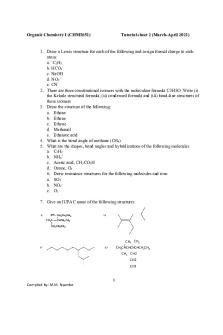Tutorial 2 PDF

| Title | Tutorial 2 |
|---|---|
| Author | Phrittivi Maharaj |
| Course | Anatomy and Physiology I |
| Institution | Humber College |
| Pages | 3 |
| File Size | 73.2 KB |
| File Type | |
| Total Downloads | 20 |
| Total Views | 160 |
Summary
TUTORIAL ...
Description
Tutorial 2 – ACIDS/BASES pH: 7.35 – 7.45 PCO2: 35mmHg – 45mmHg HCO3-: 22mmHg – 29mmHg Acid: proton donor Base: proton acceptor Major sources of H+ ions in body: nutrients you take in can be metabolized. – Carbs, proteins, fats/lipids Carbonic acid, phosphoric acid, sulfuric acid (produces protein metabolism) Keto acids – non-volatile acid; lipid production, a little protein Bicarbonate – volatile acid Buffers: neutralizes acidity, release/absorb hydrogen protons. If donating protons, it would donate to bases. Weak acid, a salt of the acid Most important is bicarbonate and carbonic acids. Buffer systems: respiratory, urinary, metabolic systems. Carbon dioxide + water carbonic acid hydrogen ion + bicarbonate CO2 + H2O H2CO3 H+ + HCO3Cells/ Blood (2) tissues (1)
Lungs (3)
Acidosis/alkalosis Acidosis 7.45
2 factors that regulate metabolic acidosis Acidosis = result in decrease in bicarb (1:20), become acidic If acid levels go up: drinking, eating a lot of aspirin, high protein diet. Alkalosis = too much bicarb, too little acid. Too much: renal failure, constipation, lube diuretics – peeing out excess acid becoming alkaline
4 acid/base problems pH of 7.25 – acidosis Rules: pH first then decide that it is acidosis. Then pco2, is it normal? Elevated? Hco3, normal? No – non compensating acidosis.
PH = 7.25 (acidosis) pCO2= 50 (not normal, elevated) HCO3= 24 (normal) -------- no compensating acidosis
B. pH = 7.10 (acidosis) pCO2= 47 (not normal, elevated) HCO3= 32 (not normal, elevated)
C. pH = 7.5 pCO2= 40 HCO3= 35
D. pH = 7.44 (alkalosis) pCO2= 34 (normal) HCO3= 21 (low) – respiratory alkalosis
Electro Phys: Unstimulated neuron can be considered a polarized neuron.
If had to draw refectory period on graph, would have to draw it at the dg of depolarization along hyper polarization. Won’t get action potential unless you have a strong stimulus.
Threshold - -55miliviles above resting potential. That’s when sodium gates open, don’t get action potation unless you reach threshold. Graded potential is if you’re not able to reach threshold
Absolute: no way to get another action potential Relative: can get action potential but must have a very strong stimulus.
Synaptic transmission: Action potential coming through presynaptic neuron. – At presynaptic neuron u need Calcium, vesicles that contain neurotransmitters, action potential comes through axon terminal, calcium must enter axon terminal. Triggers vesicles to migrate to presynaptic membrane. Exocytosis of neurotransmitters. Then diffuses cross synaptic cleft, neurotransmitters bind to receptors of post synaptic neuron. – attached to types of gates or sodium ion. Sodium then floods into cells and then new action potential starts again. After neurotransmitters bind to receptors, they get either reused, or degraded....
Similar Free PDFs

Tutorial-2
- 1 Pages

Tutorial 2
- 3 Pages

Tutorial #2
- 2 Pages

Tutorial 2
- 1 Pages

Tutorial 2 - .....
- 3 Pages

Tutorial 2
- 3 Pages

Tutorial 2
- 2 Pages

Tutorial 2 - tut 2
- 5 Pages

Tutorial 2 - Wk 2
- 6 Pages

Lab 2 treeage tutorial 2
- 10 Pages

ECON2004 Term 2 Tutorial 2
- 5 Pages

2 - nursing tutorial week 2
- 3 Pages

Week 3 - Tutorial 2 Tutorial Notes
- 12 Pages
Popular Institutions
- Tinajero National High School - Annex
- Politeknik Caltex Riau
- Yokohama City University
- SGT University
- University of Al-Qadisiyah
- Divine Word College of Vigan
- Techniek College Rotterdam
- Universidade de Santiago
- Universiti Teknologi MARA Cawangan Johor Kampus Pasir Gudang
- Poltekkes Kemenkes Yogyakarta
- Baguio City National High School
- Colegio san marcos
- preparatoria uno
- Centro de Bachillerato Tecnológico Industrial y de Servicios No. 107
- Dalian Maritime University
- Quang Trung Secondary School
- Colegio Tecnológico en Informática
- Corporación Regional de Educación Superior
- Grupo CEDVA
- Dar Al Uloom University
- Centro de Estudios Preuniversitarios de la Universidad Nacional de Ingeniería
- 上智大学
- Aakash International School, Nuna Majara
- San Felipe Neri Catholic School
- Kang Chiao International School - New Taipei City
- Misamis Occidental National High School
- Institución Educativa Escuela Normal Juan Ladrilleros
- Kolehiyo ng Pantukan
- Batanes State College
- Instituto Continental
- Sekolah Menengah Kejuruan Kesehatan Kaltara (Tarakan)
- Colegio de La Inmaculada Concepcion - Cebu


